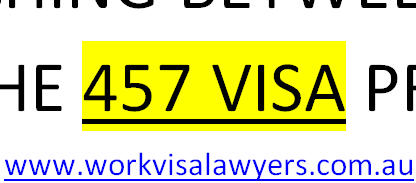2018 UPDATE
How to increase your points for Employer Sponsored Visas (Subclass 187)
How the new Skilling Australia Fund Levy Will Affect RSMS 187
The Regional Sponsored Migration Scheme visa (subclass 187), popularly referred to as the “RSMS visa” is an attractive Australian visa for professionals being sponsored to work in the regional areas of Australia. The RSMS visa grants you and your family members permanent residency in Australia. Here is an overview of what the RSMS visa allows you (and your family – partner and children) to do in Australia:
- Live in Australia indefinitely
- Work for the sponsoring company for at least 2 years
- Travel in and out of Australia repeatedly for a period of 5 years
- Study in Australia as a domestic student
- Enjoy benefits such as Medicare, First Home Buyer’s Grant, Family Tax Benefits, etc.
While it sounds very attractive, especially in comparison to the temporary work 457 visa, it is important to note that the requirements to apply for the RSMS are very different from the 457 visa application. Here are the 10 things you need to know about applying for a RSMS visa.
No. 1 – What are the regional areas in Australia for the purposes of the RSMS visa?
The regional areas of Australia include all parts of Australia except Brisbane, Gold Coast, Newcastle, Sydney, Wollongong and Melbourne.
No. 2 - The 3 streams of the RSMS
There are 3 application pathways or streams for the Regional Sponsored Migration Scheme visa (subclass 187). The 3 streams available are:
(i) Temporary Residence Transition stream
This stream is available for Temporary Work (Skilled) visa (subclass 457) holders who have worked for the sponsoring employer for at least 2 years. You will also need to meet vocational English requirements unless you are exempt. No skills assessment is required.
(ii) Direct Entry stream
This is available for applicants who:
- have never, or only briefly worked in Australia
- hold a Temporary Work (Skilled) visa (subclass 457) but do not qualify under the Temporary Residence Transition Stream
- are applying directly from outside Australia
You will need to meet competent English requirements (unless exempted) and also meet the skills requirements, which are explained in more details below.
(iii) Agreement stream
This stream is only applicable if you are being sponsored by an employer through a tailored and negotiated labour agreement. The age, skills and English requirements will be stated in the labour agreement.
No. 3 - Offer of employment in skilled position on a relevant list from an Australian business
The employer is an important part of the application process. You must have an Australian employer who is willing to sponsor you for an occupation that is on the appropriate occupation list.
For the Temporary Residence Transition stream you will need to refer to the Consolidated Sponsored Occupations List. The nominated occupation for the RSMS subclass 187 visa must have the same four-digit occupation unit group code as the occupation being carried out by the employee.
For the Direct Entry stream you will need to refer to a special legislative instrument for the list of occupations suitable for nomination. The occupations are specified in the legislative instruments IMMI 15/083 and IMMI 15/109. You will also need to seek Regional Certifying Body (RCB) approval before being able to nominate a position. More details about the RCB are explained below.
For the Labour Agreement stream you will need to check if an agreement is in place for the occupation being nominated. The occupation must have a Labour Agreement in place to be suitable for nomination.
If you need help with the position being nominated, please seek the help and advice of Work Visa Lawyers.
No. 4 – Visa applicant requirements for the RSMS Direct Entry
Applicants applying for the RSMS Direct Entry visa need to meet English, skills and age requirements.
For English applicants will need to demonstrate Competent English, which is shown by obtaining English test scores of IELTS 6.0 in all components, or equivalent alternative test scores. You will meet the English requirements if you are a holder of a valid passport issued by the United Kingdom, the United States of America, Canada, New Zealand or the Republic of Ireland.
You may be exempt from the English requirement if you command a very high salary for the position or are nominated for a select group of occupations.
The visa applicant must meet the skills and qualifications requirement for the nominated occupation. The skills and qualifications required for each occupation can be found at the ANZSCO list from the Australian Bureau of Statistics. Trade occupation applicants will need to obtain a skills assessment if the relevant qualifications were obtained outside of Australia.
Professions such as medical practitioners and nurses will need to obtain full practising registration in Australia before they can apply. As such many candidates from such professions will apply for a 457 visa first to work and obtain registration in Australia, before applying for permanent residence via the Temporary Transition stream later.
All Direct Entry 187 RSMS visa applicants need to be under the age of 50, unless exemptions apply.
No. 5 – Employer requirements for the RSMS Direct Entry
The employer will need to offer a position that is available for at least two years from the time the RSMS visa is granted. The occupation needs to be on one of the occupation lists relevant for the RSMS visa. Prior to the RSMS nomination and visa application the employer needs to apply for a Regional Certifying Body (RCB) certification. The RCB certification requires the employer to:
- advertise the position to show that the employer was unable to find a local Australian citizen or permanent resident to work in the position
- demonstrate genuine need for the position
Without a RCB approval your RSMS visa is likely to be refused by the DIBP.
No. 6 – Advantages of the RSMS Direct Entry subclass 187 visa
There are two advantages to the RSMS visa application. Firstly the nominated position is not subject to the Temporary Skilled Migration Income Threshold (TSMIT) which is $53,900. This means that unlike the 457 Temporary Work Visa the RSMS visa is suitable for occupations which have an annual market salary lower than $53,900 (such as cooks or restaurant and café managers). Secondly the RSMS occupation list has more occupations than the Consolidated Skilled Occupation List (CSOL) used for the 457 visa. A good example is Hotel Service Managers which are available for sponsorship under the RSMS visa but not for the 457 Temporary Work Visa.
Other advantages would include the exclusion from 457 visa sponsorship obligations and the fact that visa applicants (the employee and family) will receive Australian permanent residence from date of grant, with access to Medicare and international school fee waivers.
No. 7 – RSMS Temporary Transition requirements for existing 457 visa holders
The key requirements for a 457 visa holder to apply for the RSMS via Temporary Transition are:
- the applicant must have held the 457 visa and worked under the same employer for at least 2 out of the last 3 years before applying. There are very limited exceptions for this
- the employer has paid the correct salary, superannuation and withheld taxes for the work done under the 457 visa employment
- the employer meets the Training Benchmark requirements. This means that the employer has provided an acceptable amount of training for its Australian citizen and permanent resident employees, or has made a contribution to a relevant industry training fund
No. 8 – Advantages of the RSMS Temporary Transition subclass 187 visa
The required English ability for this visa application is Vocational English, which is IELTS 5.0 in all components or equivalent English test results. There is also no need for skills assessments, demonstration of skills or qualifications if the 457 visa holder has been employed in the position for at least 2 years. The Temporary Transition pathway also allows access to a health waiver, which will be helpful to a family which may have a family member who is ill. Do note that there is no guarantee that a health waiver will be granted.
No. 9 – Obligations to be met by the Employer and Employee under the RSMS visa
The most recent focus is on the “Payment for Visas” conduct where visa applicants have paid employers in return for a RSMS sponsorship. Recently passed legislation now allows both the employer and employee to be subjected to civil and criminal penalties, which include fines and imprisonment. The Department can also cancel the RSMS visa of the employee who engaged in such illegal conduct.
Additionally the Migration Act also allows the Department to cancel the RSMS visa of an employee if:
1) the employee does not start working for the employer within 6 months of arriving in Australia
2) the employee does not make a genuine effort to stay and work with the employer for at least 2 years
No.10 – Do I need help with a RSMS subclass 187 visa?
The RSMS involves multiple stages and can be a complex application for both the employer and employee. In 2014 73.8% of RSMS applications submitted were prepared by Registered Migration Agents.
More importantly using the services of a Registered Migration Agent provides accountability, consumer protection and expertise required to submit a strong application on your behalf.
At Work Visa Lawyers we have a team of Immigration Lawyers and Registered Migration Agents who can assist you with RSMS applications regardless of the industry.
Time stamps
0:44 - #1 What are the Regional Areas in Australia?
1:30 - #2 The streams to an RSMS - Direct Entry, Temporary Transition and Labour Agreement
2:21 - #3 Offer of employment in skilled position on a relevant list from an Australian business
4:29 - #4 RSMS Direct Entry requirements for the visa applicant
6:10 - #5 RSMS Direct Entry requirements for the employer/business sponsor
7:09 - #6 Advantages of the RSMS Direct Entry pathway
8:16 - #7 RSMS Temporary Transition requirements for the visa applicant
8:58 - #8 Advantages of the RSMS Temporary Transition pathway
9:53 - #9 Obligations of the RSMS visa for visa applicant and employer sponsors
10:55 - #10 Do I need help with a RSMS subclass 187 visa
Hope you found the video helpful! Remember to subscribe to the Work Visa Lawyers channel for more videos.
You can find more information about the RSMS visa from the Work Visa Lawyers blog articles:
http://www.workvisalawyers.com.au/new...
http://www.workvisalawyers.com.au/new...
http://www.workvisalawyers.com.au/new...
Work Visa Lawyers is experienced in a variety of Australian visa application, including:
Employer Sponsored Visas | 457 visas | RSMS 187 visas | ENS 186 visas | Standard Business Sponsorship | Meeting Training Benchmarks and Creating Training Plans | RCB certification | Labour Market Testing | Market Salary Research | General Skilled Migration | State Nomination | Partner visas | Parent visas | Business Migration visas | and others.
Contact Work Visa Lawyers today if you need help with an Australian visa application.
This information is accurate on 21 October 2016
Do you need help with an Australian visa application?
At Work Visa Lawyers we are experienced in assisting applicants in all matters relating to Australian visa applications. Our areas of expertise include Skilled Migration visas, Business Skills Migration visas, Employer Sponsored Work Visas, Partner and other Family Migration visas as well as the Administrative Appeals Tribunal (AAT) Review, Judicial Review and Ministerial Intervention.
If you require further information regarding your Australia visa options you can contact us through:
(08) 8351 9956 or +61 8 8351 9956
or This email address is being protected from spambots. You need JavaScript enabled to view it.













